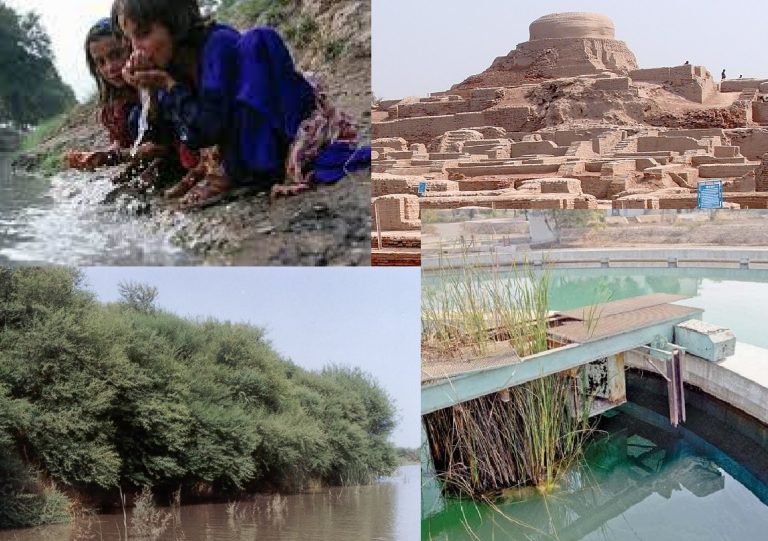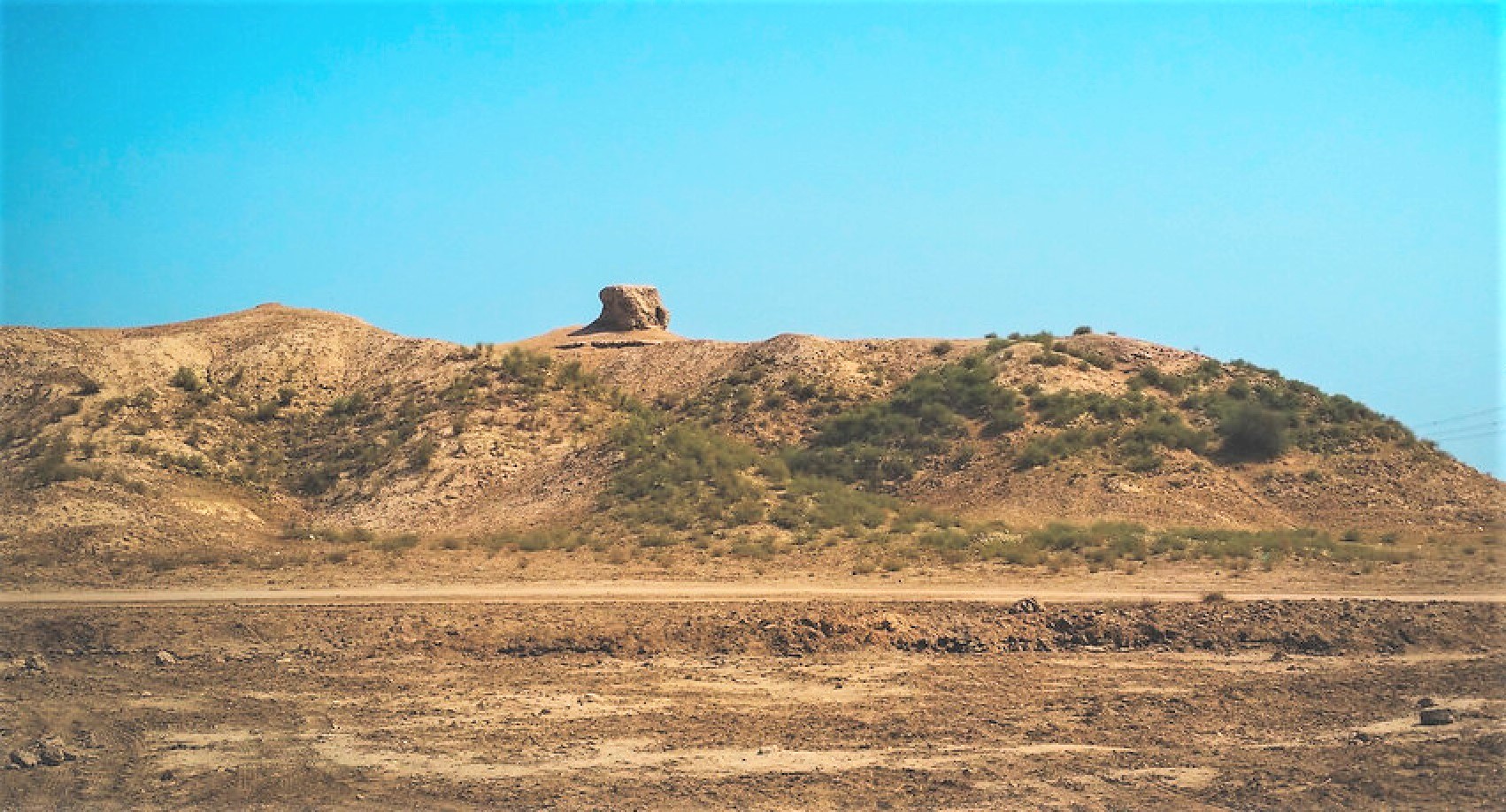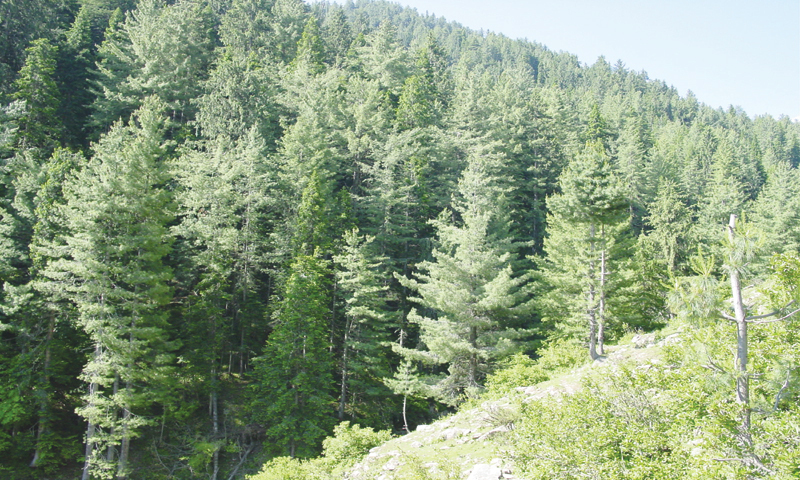
To combat the negative consequences Climate Change, we must move beyond politics to formulate short-term and long-term policies that will secure the region’s ecological future and our own.
Researched and written by Nusrat Sikandar
Translated by Yasir Qazi
Climate change includes global warming, air pollution, water pollution, rapid depletion of natural resources, large-scale deforestation, global warming, and constant rainfall (including the sea level rise) substandard water used for drinking and irrigation purposes, etc. The afore-mentioned surge in the sea level expands the risks to the coastal areas, which are also a cause for concern.) Like the rest of the parts of the country, several areas of the Larkana district are being severely affected, including the groundwater in the district and its environs, the water level in terms of taste, as well as the forests and archaeological sites in the area are being severely affected by environmental disturbances.
The deleterious effects of climate change on this planet have been compounded since the planet came into being. Right from the ice age to the flooding of this sphere, and to this day, the earth has been in the grip of the aforementioned negative climate change due to water scarcity as a whole. We all know that Pakistan is an agricultural country, which is, unfortunately, one of the most backward countries in the third World. One of the reasons for this is that it is severely affected by adverse environmental consequences. These effects are severely damaging the entire country, including Sindh, and the historic district of Larkana in the north and its environs.
An overview of Larkana’s declining groundwater
Water is one of the three most important natural components of life and the most important element for the survival of every living thing. As in other parts of Sindh and Punjab, the groundwater level in different parts of Larkana is declining rapidly. Residents of Larkana have been using only groundwater for their daily use, including drinking, which is no longer usable due to adverse environmental effects. According to a study published in issue No. 11 of “International Journal of Scientific and Engineering Research”, based on physical and chemical examination and research of the groundwater samples in the Larkana taluka, the results are as follows:
The groundwater here is colorless, with no apparent dirt (i.e. the average consumer considers this water clean), but about 13.95% of the samples of this water tasted bitter and salty. In the approximate 53.48%, 83.72%, 20.93% and 83.72% groundwater samples respectively. ‘E’, ‘E. C’, ‘T’, and ‘T. D.’ ingredients of SK have been found, the amount of which in this water has exceeded the due limit, and according to the standards set by the ‘World Health Organization’ (WHO), such a high proportion of these ingredients in water is brutally injurious to the human health. Approximately all areas here, are not using water according to the standards (both physically and chemically) set by the WHO. These areas include ‘Lashari’, ‘Zikrio Mahessar’, ‘Rasheed Wagann’, ‘Shah Hassan’, ‘Gul Muhammad Chhawaro’, ‘Shah Baig Jamali’ and ‘Mehmood Dero’. People in these areas either fetch water from other far areas for their daily use, or they are compelled to drink the same contaminated water. Overall, 27.9% of the research area found substandard and unusable groundwater.
The examination of the amount of arsenic in this groundwater shows that the amount of arsenic in the groundwater samples is even more than approximately 53.48%, 83.72%, 20.93% and 83.72% respectively. According to research, a review of the “TDS status” in the groundwater here has shown that the toxic substances and the “TDS concentration” in the groundwater samples are above the required level. There are many areas where people are suffering from various stomach ailments due to the lack of potable water.
Affected Forests of Larkana District
Forests have been the source of beauty and prosperity of Sindh since ancient times. The area around both banks of the Indus River is called ‘Kacha’. There are ornamental forests on the raw land that is inhabited and fertile due to river water, in which plants and trees like ‘Bahan’, ‘Pann-e’, ‘Kanhan’ and ‘Vachellia nilotica’ (called ‘Bbabbur’ in Sindhi) etc. are found in large quantities. Grass and weeds always grow on the moist soil here. Forests and shrubs grow naturally in the wetlands. Forests, along with economic prosperity, provide us with pure honey, bird sanctuaries, river flood prevention and many other benefits, while weeds and shrubs provide us with fodder and many herbs.
Riverine Forests: In Sindh, there are riverine forests on both sides of the Indus River, the amount of which is declining day by day due to rapid deforestation and environmental degradation. Their perpetuation all depends on the return of the river. Therefore, the existence of riverine forests depends only on the flow, speed and abundance of water in the Indus River. According to the Encyclopedia Sindhiana, “Forests prevent floods. The main trees of these forests are ‘Vachellia nilotica’ 60%, ‘Kundi’ 14%, ‘Mesquite’ (Devi) 12%, ‘Lai’ 9% and miscellaneous trees 5%.
The soil and dust that flows along with the river help in the growth of a variety of commodities, including sugarcane, ‘Lai’ and ‘Sufaido’. By giving strength to such land, ‘Vachellia nilotica’ and grass grow. During the dry season, plants like ‘Kundi’, ‘Jaar’ / ‘Khabar’ (the toothbrush tree), ‘Capparis decidua’ (Kirirr), ‘Acacia senegal’ (Kuhumbhat) and ‘Bawari’ also grow. Riverine forests are not only the mainstay of Sindh’s forests but also a source of employment for thousands of people, because, they get fuel, timber, fodder, honey and tannins. In addition, these forests are a treasure trove of carbon dioxide, as well as protecting the surrounding areas from flooding. Only barely 50% of riverine forests can be submerged. As a result, it is possible to save a small percentage of riverine forests.
Canal Forests: These forests were formerly known as “River Forests”, but were later separated from the Indus River by the construction of flood dams. It simply came to our notice then. Now, these forests are abating day by day due to scarcity of water, unevenness of land, bean and sorghum and also due to lack of funds for afforestation and maintenance. The major trees growing in these forests are ‘Vachellia nilotica’ 58%, ‘Indian Rosewood’ (Taal’hee) 20%, Eucalyptus 10%, ‘Muskweed’ (Devi) and other trees 12%.
Marine Forests (Mangrove-forests): Marine forests are considered to be the sixth-largest forests in the world. They thrive in salty and low oxygen sludge. In terms of the environment, they are of great importance in maintaining the natural system. At the same time, they are a haven for a wide variety of flora and fauna, as well as aiding in the laying and breeding of fish and prawns. The trees in these forests contain 99% Mangrove trees and barely 1% other trees.
Riverine forests in the Larkana district cover an area of 2,312 acres, of which a large portion consists of ‘Dossu Forest’. In addition, 18 forests are currently under the management control of ‘Larkana Forest Division’, including ‘Amrot Forest’ (consisting: 8,045 acres), ‘Madiji Forest’ (8,892 acres), ‘Aaqil Forest’, ‘New Abad Forest’, ‘Gaaji-Dero Forest’, ‘Sharif-pur Forest’, ‘Hassan Wahnnrr Forest’, ‘Ghanghro Forest’, ‘Tatri’ and ‘Aaganni Forest’. The major and largest lakes and reservoirs of Larkana district include 164 hectares ‘Drigh lake’, 19 hectares ‘Langh Lake’ and 11 hectares ‘Khatt Dhoro’. All these three “wetlands” are declared as ‘Protected zones’ by the government. Like other parts of northern Sindh, most of the forests in the Larkana district have been cut down in the name of operation against dacoits, and nature has been toyed with. The “dry spells” that followed the “wet spells” after a few years regularly have had a negative impact, with droughts in the Indus river destroying forests and other remaining forests rapidly. In addition to the environmental problems and anguishes with the forests here, another major problem is that the local ‘Occupation mafia’ is leaving no stone unturned in capturing the forests like the common land. According to a report published in the well-reputed English newspaper Dawn on June 29, 2014, more than 12,000 acres of forest land in the Larkana division has been taken over by the Mafias, from which there is no one to relinquish this possession. The provincial government is constantly making claims that “all legal means will be used to fight the occupation mafia.”, But yet, these are proved to be claims only.
Forests are very effective weapons to combat natural floods, but the deforestation of countless trees in illegally occupied forest lands not only pushes the region and its population to the brink of potential catastrophe. In fact, it is constantly damaging the entire “ecosystem” and wildlife. To protect the forests from all these human as well as natural attacks, the Forest Department of the Government of Sindh in collaboration with the ‘Environmental Protection Agency’ (EPA, Sindh) will have to formulate such a strategy to save the forests through a comprehensive plan; so that our forests not only continue to play their defensive role during the flood season but also during the famine season, their protection can be significantly improved, in this regard through large-scale afforestation campaigns, to some extent. Attempts can be made to offset the damage done so far and far-reaching policies can be formulated to achieve progressive results.

Archaeological Survey of Larkana District
“Archaeology” means: ‘old or ancient signs’. The archaeological sites that provide information on the history of a region and its ancient heritage are the real assets of land, without which a region is ‘mirror-less’. Among the archaeological sites in the Larkana district, ‘Mohenjo Daro’ is a well-known international tourist destination as well as a ‘World Heritage Site’, declared by UNESCO. The monuments of the ancient civilization of ‘Mohenjo Daro’, which are more than five thousand years old, are located near the city of Dokri, in the district.
Other archaeological sites in Larkana District include ‘Jhukkar Jo Daro’, located 18 km from Larkana on the Indus Highway. The pottery, bronze coins, seals and spears found in the excavations of this city spread over a large area of land, indicate that this city was settled long after the civilization of ‘Mohenjo Daro’. Fifth-century coins and a Buddhist stupa have also been found in ‘Jhukkar Jo Daro’. There is also ‘Chotiariyoon Daro’ (Ranni’a Jo Daro) near ‘Jhukkar Jo Daro’. These archaeological sites, which can be seen up to 50 feet high, are spread over a large area, from which various metal and earthenware vessels and coins have also been found.
The other archaeological sites around Larkana include ‘Khairpur Jussay waro Daro’, ‘Dhamrahan Jo Daro’ and ‘Bhaando Qubo’ near Ratodero. All these traces of the past are disappearing day by day due to the negative environmental effects. These adverse environmental effects include the devastation caused by beans and thorns, the damage caused to these monuments by rains, the heat caused by summer heatwaves and the adverse effects caused by storms. This includes the brutal destruction of these monuments, the atrocities committed by gangs of youths riding motorcycles on them, and the shameful acts of stealing bricks and stones from different parts of these sites. The negative effects of human intervention on these monuments can be prevented with the attention of local administrations and the possible austerity measures they may take (if this is done!), but against the actions of nature, including climate change, no one can be prosecuted for, but changing our lifestyles can prevent these negative environmental effects from occurring.
According to archaeological connoisseurs from the Sindh Government’s Department of Antiquities, only 22% of the total land area of ‘Mohenjo Daro’ has been excavated so far. There will be a great challenge, which, if not met, is likely to wash away the complete relics of this civilization, which is more than 5,000 years ancient, within the next few decades.
Over the past half-century, rapid climate change has been having a negative impact on the archaeology of our region, especially the Larkana district, including normal human life, which the Sindh government has sought to protect against. The Department of Culture, Tourism and Antiquities, with the cooperation and guidance of foreign experts, needs to take serious urgent steps to enable us to preserve our “Constitutions of the past” and we can protect it before it is lost like our present.
During the current year, on June 5, 2021, Pakistan had the honor of hosting an international conference on the occasion of World Environment Day, in which, under the supervision of a 12-member board, Pakistan for the first time received the chairmanship of the ‘World Environment Fund’ (WEF). This is an honor we have received for the first time. As a result, it is now imperative for us to take steps to avoid adverse local climate change. Hosting this conference is a positive and welcome thing for the country on the one hand and an important pride, on the other hand, we have a huge responsibility to solve the country’s environmental problems, which Pakistan has to do at any cost. In addition, it is a golden opportunity to fulfil this core liability by addressing the environmental issues, faced by the region effectively, which affects every element of the land, human life, rivers, seas, deltas, agricultural lands, deserts, mountains, birds and other living beings. To combat the negative consequences of weather, over the present and future of the region and the rest of the world, we must move beyond politics to formulate short-term and long-term policies that will secure the region’s ecological future and our own. ‘Our home’ (this planet) could be made habitable for hundreds of generations to come. There can be no more precious gift for future generations than a clean and tidy sphere to live, that we can give them.
______________________
 The author is a freelance Sindhi journalist, columnist and writer, writing since 2014. She is an ‘East-West Center Alumni Association’ (EWCAA) fellow journalist.
The author is a freelance Sindhi journalist, columnist and writer, writing since 2014. She is an ‘East-West Center Alumni Association’ (EWCAA) fellow journalist.
 The translator is a freelance radio and TV broadcast and print journalist, poet, prose-writer, researcher, columnist, blogger, translator, media Expert, and author of 12 books in Sindhi. He writes regularly for esteemed English, Urdu and Sindhi papers and websites.
The translator is a freelance radio and TV broadcast and print journalist, poet, prose-writer, researcher, columnist, blogger, translator, media Expert, and author of 12 books in Sindhi. He writes regularly for esteemed English, Urdu and Sindhi papers and websites.
